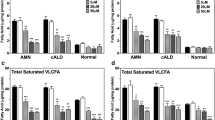Summary
Patients with Zellweger syndrome and related peroxisomal disorders have profound changes in the polyunsaturated fatty acid (PUFA) patterns in brain and other tissues, with a constant decrease in docosahexaenoic acid (DHA, 22:6ω3) concentration. Arachidonic acid (AA, 20:4ω6) concentration is normal or increased and linoleic acid (LA, 18:2ω6) is increased in the brain of Zellweger patients. In the retina of these patients, the levels of DHA are extremely low. Since these alterations are reflected elsewhere, they can be detectedin vivo in patients with generalized peroxisomal disorders by measuring the PUFA content of plasma and erythrocytes, which show very low concentrations of DHA. The concentration of AA is low in plasma in generalized peroxisomal patients, although it is within normal limits in erythrocytes. Patients with X-linked adrenoleukodystrophy (X-ALD) or adrenomyeloneuropathy (AMN) have a normal DHA and AA content in both plasma and erythrocytes, unless they receive extremely low-PUFA diets.
Given the probable role of DHA deficiency in the pathogenesis of Zellweger syndrome (ZS), it is important to normalize concentrations of DHA, at least in blood, in an attempt to correct the DHA deficiency in brain. DHA ethyl ester was given orally to two infants with a peroxisome deficiency disorder for a year, and some favourable biochemical changes were produced in erythrocytes and plasma. Normalization of the DHA concentrations in erythrocytes was obtained in about 2 months, and the ratios 26:0/22:0 and 26:1/22:0 decreased markedly in plasma in the two patients. The plasmalogen ratio 18:0 dimethyl acetal/18:0 in erythrocytes increased to virtually normal values in both patients. There was a clear clinical improvement in the two patients, which paralleled the increase in blood DHA. The concentrations of AA and other PUFAs were closely monitored and, when necessary, AA was added to the diet. Such a DHA therapy, given under close biochemical and clinical control, and accompanied by a diet rich in other long-chain PUFA, is strongly recommended in all patients with peroxisomal disorders in whom a DHA deficiency is detected in blood.
Similar content being viewed by others
References
Anderson E, Benolken RM, Dudley PA, Landis DJ, Wheeler TG (1974) Polyunsaturated fatty acids of photoreceptor membranes.Exp Eye Res 18: 205–213.
Breckenridge WC, Gombos G, Morgan IG (1972) The lipid composition of adult rat brain synaptosomal plasma membranes.Biochim Biophys Acta 266: 695–707.
King ME, Stevens BW, Spector AA (1977) Diet-induced changes in plasma membrane fatty acid composition affect physical properties detected with a spin-label probe.Biochemistry 16: 5280–5285.
Martinez M (1989) Polyunsaturated fatty acid changes suggesting a new enzymatic defect in Zellweger syndrome.Lipids 24: 261–265.
Martinez M (1990) Severe deficiency of docosahexaenoic acid in peroxisomal disorders: A defect of Δ4-desaturation?Neurology 40: 1292–1298.
Martinez M (1992a) Tissue levels of polyunsaturated fatty acids during early human development.J Pediatr 120: S129–138.
Martinez M (1992b) Abnormal profiles of polyunsaturated fatty acids in the brain, liver, kidney and retina of patients with peroxisomal disorders.Brain Res 583: 171–182.
Martinez M (1992c) Treatment with docosahexaenoic acid favorably modifies the fatty acid composition of erythrocytes in peroxisomal patients. In Coates PM and Tanaka K, eds.New Developments in Fatty Acid Oxidation. New York: Wiley-Liss, 389–397.
Martinez M, Pineda M, Vidal R, Martin B (1993) Docosahexaenoic acid — a new therapeutic approach to peroxisomal-disorder patients: Experience with two cases.Neurology 43: 1389–1397.
Martinez M, Mougan I, Roig M, Ballabriga A (1994) Blood polyunsaturated fatty acids in patients with peroxisomal disorders. A multicenter study.Lipids 29: 273–280.
Moser AB, Borel JS, Odone A, et al (1987) A new dietary therapy for adrenoleukodystrophy: biochemical and preliminary clinical result in 36 patients.Ann Neurol 21: 240–249.
Nariai T, Hirakawa K, Imahori Y, et al (1993) Synthesis of14C labeled docosahexaenoic acid for imaging of neuronal structure and function.J Cereb Blood Flow Metab 13: S704.
Neuringer M, Connor WE, Lin SD, Barstad L, Luck S (1986) Biochemical and functional effects of prenatal and postnatal 3 fatty acid deficiency on retina and brain in rhesus monkeys.Proc Natl Acad Sci USA 83: 4021–4025.
O'Brien JS, Sampson EL (1965) Fatty acid and fatty aldehyde composition of the major brain lipids in normal human gray matter, white matter and myelin.J Lipid Res 6: 545–551.
Rizzo WB, Leshner RT, Odone A, et al (1989) Dietary erucic acid therapy for X-linked adrenoleukodystrophy.Neurology 39: 1415–1422.
Roels F, Fischer S, Kissling W (1993) Polyunsaturated fatty acids in peroxisomal disorders: a hypothesis and a proposal for treatment.J Neurol Psychiatr 56: 937.
Samson JF, Jakobs C, van de Klei-van Moorsel J, Smit LME, Schutgens RBH, Wanders RJA (1992) Zellweger syndrome in a preterm small for gestational age infant.J Inher Metab Dis 15: 75–83.
Sarda N, Gharib A, Moliere P, Grange E, Bobillier P, Lagarde M (1991) Docosahexaenoic acid (cervonic acid) incorporation into different brain regions in the awake rat.Neurosci Lett 123: 57–60.
Voss A, Reinhart M, Sankarappa S, Sprecher H (1991) The metabolism of 7,10,13,16,19-docosapentaenoic acid to 4,7,10,13,16,19-docosahexaenoic acid in rat liver is independent of a 4-desaturase.J Biol Chem 266: 19995–20000.
Author information
Authors and Affiliations
Rights and permissions
About this article
Cite this article
Martinez, M. Polyunsaturated fatty acids in the developing human brain, erythrocytes and plasma in peroxisomal disease: therapeutic implications. J Inherit Metab Dis 18 (Suppl 1), 61–75 (1995). https://doi.org/10.1007/BF00711429
Issue Date:
DOI: https://doi.org/10.1007/BF00711429




